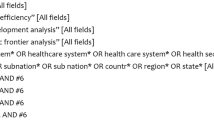Abstract
This paper describes how conjoint analysis can be applied to health care marketing. Data from a sample of 73 university students were used to estimate part-worth values for different levels of attributes of ambulatory care arrangements. A high degree of comparative validity was found.
Similar content being viewed by others
References
MacStravic, R.,Marketing Health Care Services Aspen System, Germantown, Maryland, 1978.
Acito, F., and Jain, A., Evaluation of conjoint analysis results: A comparison of methods.J. Mkt. Res. 17:106–112, 1980.
Cattin, P., and Wittink, D. Commercial use of conjoint analysis: A survey. Research paper, Stanford University, Graduate School of Business, 1981.
Roghmann, K., et al., Who chooses prepaid medical care: Survey results from two marketings of three new prepayment plans.Public Health Rep. 90:516–527, 1975.
Berki, S., Ashcraft, M., Penchansky, R., and Fortus, R., Enrollment choice in a multi-HMO setting: The roles of health risk, financial vulnerability, and access to care.Med. Care, 15:95–114, 1977.
Gaus, C., Who enrolls in a prepaid group practice: The Columbia experience.Johns Hopkins Med. J. 128:9–14, 1971.
Gross, P., Economics of health facility location.Int. J. Health Services 2:63–84, 1972.
Juba, D., Lave, J., and Shaddy, J., An analysis of the choice of health benefits plans.Inquiry 17:62–71, 1980.
Tessler, R., and Mechanic, D., Factors affecting the choice between prepaid group practice and alternative insurance programs.Milbank Memorial Fund Q. 53:149–172, 1975.
Green, P., and Wind, Y.,Multiattribute Decisions in Marketing: A Measurement Approach, The Dryden Press, Hinsdale, 1973.
Lancaster, K., A new approach to consumer theory.J. Polit. Econ. 74:132–157, 1966.
Dawes, R., and Corrigan, B., Linear models in decision making.Psychol. Bull. 81:95–106, 1974.
Green, P., and Devita, M., The robustness of linear models under correlated attribute conditions.1975 Educators' Conference American Marketing Association, Chicago, 1975, pp. 108–111.
Green, P., and Srinivasan, V., Conjoint analysis in consumer research: Issues and outlook.J. Consumer Res. 5:103–123, 1978.
Adelman, S., Orthogonal main-effect plans for asymmetrical factorial experiments.Technometrics (February) 25–31, 1962.
Green, P., On the analyses of interactions in marketing research data.J. Mkt. Res. 10:410–421, 1973.
Cattin, P., and Wittink, D., A Monte-Carlo study of metric and non-metric estimation methods for multiattribute models. Research Paper No. 341, Stanford University, 1976.
Carmone, F., Green, P., and Jain, A., The robustness of conjoint analysis.J. Mkt. Res. 15:110–122, 1978.
Newhouse, J.,The Economics of Medical Care Addison-Wesley, Reading, 1978.
Author information
Authors and Affiliations
Rights and permissions
About this article
Cite this article
Rosko, M.D., Walker, L.R., McKenna, W. et al. Measuring consumer preferences for ambulatory medical care arrangements. J Med Syst 7, 545–554 (1983). https://doi.org/10.1007/BF00995184
Issue Date:
DOI: https://doi.org/10.1007/BF00995184




